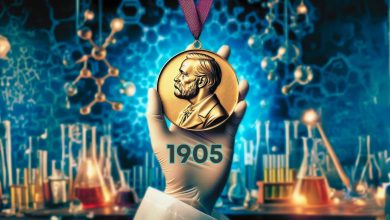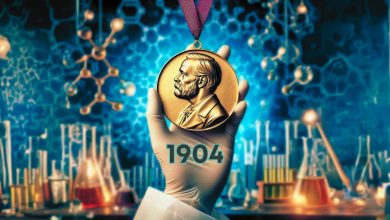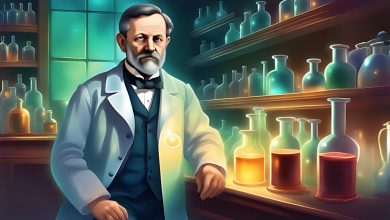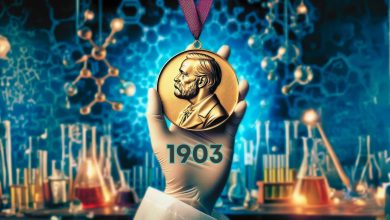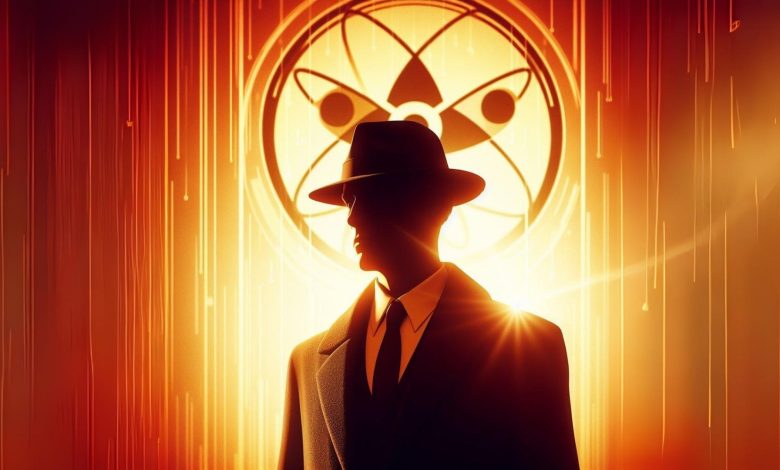
Oppenheimer is a name we come across wherever we look these days. We have always remembered him as the “Father/Inventor of the Atomic Bomb”, but Oppenheimer was someone who had an important place in the world of science before his work on this project. In this article, we will take a closer look at Oppenheimer and get to know him much better.
A Genius is Born!
Julius Robert Oppenheimer was born on April 22, 1904, in New York City. Oppenheimer, who took the name Julius from his father, used his name as J. Robert throughout his life, and when asked what the abbreviation “J.” meant, he replied, “It doesn’t mean anything, just J.“.

Oppenheimer, whose father was a textile merchant and mother a painter, was the first child of a well-to-do family of German Jewish immigrants. However, according to his friends, he was not spoiled at all, on the contrary, he was very generous. His parents realized that Robert was a genius when he was just a little boy. Little Robert loved collecting rocks and wrote letters to the New York Mineralogical Club about the rocks he had collected. With a special interest in mineralogy, Robert attended a private school that offered courses in many different fields, including ethics and literature, and then went on to Harvard University, where he earned a bachelor’s degree in chemistry. Although he majored in chemistry, Oppenheimer also took courses in mathematics, history, and philosophy. He was also interested in physics thanks to his thermodynamics teacher, Percy Bridgman, who won the Nobel Prize in Physics. Oppenheimer, who was very successful, graduated from school in 3 years with honors. In these 3 years, although he did not make much progress in his social life, he immediately distinguished himself academically. He also met Niels Bohr, whom he would meet again years later, at a conference at Harvard.

After his undergraduate studies, Oppenheimer set his sights on Europe for his higher education. The work done at that time was groundbreaking in the world of science. With the discovery of the proton and neutron by Rutherford and Chadwick and Bohr’s atomic model, which is still valid today, there were many new areas to study. There was so much to learn and experiment with. At first, he applied to Ernest Rutherford for a place in the Cavendish laboratory at Cambridge, but was rejected. Although Rutherford did not accept Oppenheimer’s application, he forwarded it to his teacher, J.J. Thomson, who gave it a favorable review. Although Oppenheimer was upset that he had been rejected by Rutherford, he was happy that Thomson had accepted him. Thus, Oppenheimer switched his field of study to experimental physics and left for Europe.
Forbidden Apple
But the European adventure did not start well for Oppenheimer. At Cambridge University, it was torture for him to do some of his work in the laboratory. He had a very bad relationship with his advisor, Blackett. He is even said to have left a poisoned apple on Blackett’s desk for this reason. Over the years, several of Oppenheimer’s friends have claimed that he confessed to having done such a thing. However, there are a few questionable facts about the authenticity of this event. There is a deviation of about 6-7 months in the date of the event in the confession given by his friends. Oppenheimer was not in a very good psychological state at the time, and although he did not elaborate, he was diagnosed with “dementia praecox”, which used to describe schizophrenia. Similarly, there are rumors that Oppenheimer was diagnosed with “psychosis”. Some of his friends were therefore unsure whether this confession was real or imaginary. However, his close friend Fegusson stated that the incident was real and that Oppenheimer even risked being expelled from Cambridge, but was not expelled as a result of his father’s lobbying. What was inside the poisoned apple was never found out. According to those who knew Oppenheimer and heard the story from him, it was not a poison, but a mixture that would irritate the intestines.

After this apple incident, Oppenheimer met Max Born, a German physicist. Born had added the term “quantum mechanics ” to the lexicon and had played a role in the education of Heisenberg, Eugene Wigner, Wolfgang Pauli, and Enrico Fermi. Born was so impressed by this young man that he invited him to join his work at the University of Göttingen, where he worked. Oppenheimer accepted the offer and began to engage in research that made him much happier. In the following days, the two of them would produce a study called the “Born-Oppenheimer Approach “. Oppenheimer’s other colleagues were Nobel Prize winner James Franck and Otto Hahn, who would play a major role in the discovery of nuclear fission. Max Born would go on to win the Nobel Prize in Physics in 1954.
The scientific world was experiencing the golden age of quantum theory. Countless new papers were being published. The University of Göttingen was the school that published the most papers on this subject. Oppenheimer himself published seven papers during his time at Göttingen. Although quantum theory was popular, Einstein, arguably the most famous name in the field of physics, was not so keen on quantum, so much so that Oppenheimer expressed his dissatisfaction in a letter to his brother after a visit to Einstein. “Einstein is a nutcase,” Oppenheimer wrote. Even though Einstein was not in favor of the subject, there were many people in Europe who were interested in it. Perhaps the most interesting of these names was Heisenberg.

In 1927, Oppenheimer’s work included Heisenberg’s discoveries. Oppenheimer had admiration and respect for Heisenberg. But of course, he did not know at the time that years later his biggest rival in the race to build the atomic bomb would be Heisenberg himself. One of Oppenheimer’s most important studies at Göttingen – perhaps the most important – was on quantum tunneling. Oppenheimer wrote the world’s first publication on this subject. (If you are interested in quantum tunneling, we recommend that you take a look at this article: The Reason Why Chemical Reactions Happen Much Faster Than Expected: Quantum Tunneling) In the same year, Oppenheimer defended his doctoral thesis with extraordinary success. His thesis defense was so successful that James Franck, one of the members of the thesis jury, commented, “We got out just in time. Otherwise, he would have started asking us questions.”
After his successes at Göttingen, Oppenheimer accepted an offer from the California Institute of Technology (Caltech), despite having received offers from many prestigious institutions. A year later, he began teaching, splitting his time between the California Institute of Technology and the University of California. Here he befriended the chemist Linus Pauling, who would later win two Nobel Prizes. Pauling’s biographer Thomas Hager explains: “Pauling found him witty, interesting and a welcome antidote to the deadly dullness of much of the Caltech faculty.” So they quickly became close friends. However, their friendship did not last long. Oppenheimer asked Pauling’s wife, Ava Helen, to accompany him on a trip to Mexico, which ended their friendship. Years later, Oppenheimer asked Pauling to head the chemistry department of the Manhattan Project, but Pauling declined, citing his health problems.
During Oppenheimer’s Caltech adventure, he was inundated with offers. After evaluating the offers, Oppenheimer decided to go to Zurich for a year. Before starting his new adventure in Zurich, Oppenheimer attended a conference in Leipzig, Germany, and once again crossed paths with his future rival, Heisenberg. Although there was no friendship between the two, their respect for each other was once again multiplied.
“The Gospel of Quantum Physics”
After his second European adventure, Oppenheimer began lecturing at the University of California. However, the content of his lectures was both too heavy for the students and too fast for them. When he tried to slow down his lectures, he was not satisfied and said, “I am moving so slowly that I am not getting anywhere.” His students said, “We used to wait for him to take the chalk in his mouth one day and write on the blackboard with a cigarette,” because he was always smoking while lecturing at a fast pace. His students were not the only ones who had trouble understanding Oppenheimer. Professor Richard Tolman of the California Institute of Technology said after listening to his friend’s lecture, “Robert, your lecture was very good, but I didn’t understand a single word.” At the beginning of his teaching, Oppenheimer was said to have terrorized his students and made hurtful comments. But day by day, he was striving to get much better at teaching. In the following years, he succeeded. His students, who loved him very much, began to wear his clothes and smoke the same brand of cigarettes. Many of them were even inspired by him in the way they spoke and gestured. Oppenheimer was also making a name for himself as a leader in theoretical physics. He came up with the first theories about the existence of the positron (antielectron). Despite such incredible achievements, Oppenheimer’s arithmetic was very bad, and he often made simple math mistakes while lecturing or working.
Today, scientists agree that Oppenheimer’s most original and groundbreaking work came in the late 1930s. Oppenheimer coined the terms neutron stars and white dwarfs and predicted the properties of these astronomical masses. These predictions would only be observed in 1967. Oppenheimer was so advanced in his field that many of his colleagues considered him capable of writing the “Bible of quantum physics”.
The 1930s were a period of many developments both for Oppenheimer’s career and his political views. Oppenheimer, who had not had much to do with politics until then, began to sympathize with communist thought. He made many friends who were members of the Communist Party and organized events for its benefit. But the exact details of his involvement with the party remain a mystery to this day. Many members of this new social group were under surveillance by the FBI and other government authorities, and he was now under the microscope, but he didn’t know it yet. The FBI would open a file on Oppenheimer in March 1941. In addition to his closeness to the Communist Party, Oppenheimer also provided financial support to scientists seeking to escape the rising Nazi repression in Germany.
Introduction to the Manhattan Project and an Atomic Race
Before the start of the Second World War, it was clear to the scientific community that some kind of nuclear bomb was possible. Leo Szilard, a physicist who was one of the inventors of the nuclear reactor with Enrico Fermi, was very afraid that the Nazis would build this possible bomb. Therefore, Szilard thought that the American President Roosevelt should be warned about this issue. He convinced Albert Einstein to write a letter to the president on the subject. However, contrary to popular belief, Szilard wrote the letter and Einstein signed it. However, there was some disagreement about how the bomb would work. Uranium-235 was thought to be essential for the bomb. Some thought that the bomb was not possible because this isotope was very difficult to obtain, and others thought that even if the element could be obtained, there was a high probability that the bomb would not work. However, despite all these doubts, research for the bomb began both in America and Nazi Germany. Ernest Lawrence, one of those in charge of the project in America, began to fear that the Nazis were far more technologically advanced than they were. He was not alone in this fear. They needed more brainpower. It was at this time, at Lawrence’s insistence, that Oppenheimer became involved in the research, despite doubts about his political views. Having honed his skills as a teacher and leader, Oppenheimer began to search for a design with those who could help with the project. As a result of the calculations made, theoretical physicist Edward Teller thought that the bomb could trigger nitrogen in the atmosphere and hydrogen in the oceans, and began to worry that some kind of apocalypse could occur as a result of this trigger. Teller conveyed these concerns to Oppenheimer. Oppenheimer, who shared these concerns, forwarded the matter to Compton. Compton’s comment was as follows: “It is better to accept Nazi slavery than to draw the final curtain on humanity. ” In addition to all these apocalyptic scenarios, there was also political pressure on Oppenheimer. Many officials thought he should be removed from the project. Leslie Groves, the military official in charge of the project, defended Oppenheimer by saying, “Give me the name of someone better who can do this job.”

The race to build the bomb was now a well-known secret in the scientific world. But almost everyone thought the Nazis were ahead. This did not demoralize the team Oppenheimer was leading; on the contrary, Oppenheimer used it as a source of inspiration for his team. In October 1942, Oppenheimer received a very interesting letter. In it, physicist Victor Weisskopf conveyed news he had received from Wolfgang Pauli. Weisskopf stated that Werner Heisenberg was the head of the Nazis’ research and that Heisenberg would give a lecture in Switzerland. During this lecture, Weisskopf suggested that Heisenberg should be kidnapped or killed. Oppenheimer forwarded this letter to the necessary authorities, and even someone was sent by Leslie Groves to follow Heisenberg in Switzerland. But nothing was done to Heisenberg for fear that anything happening to him might make the Nazis suspicious that the Americans were also trying to build an atomic bomb.
The race continued unabated. As the work gained momentum, the pressure on Oppenheimer increased. The source of this pressure was the concern about whether the bomb could be built before the Nazis and Oppenheimer’s political views. Documents uncovered years later show that the authorities tried everything to fire Oppenheimer, but could not fire him because there was no one else who could do the job. These fears were unfounded because Oppenheimer had never leaked information or acted as a spy.
“Bohr is a God, Oppenheimer is a prophet.”
By 1943, plans were in place for the assassination of another scientist: Niels Bohr. The architect of modern atomic theory, Bohr, was an undisputed leader in his field. Oppenheimer admired Bohr, whom he met several times over the years. These two scientists would be described years later as “Bohr was a god and Oppenheimer was a prophet. ” Oppenheimer was very keen to involve Bohr in the Manhattan Project. Nazi Germany, aware of this situation, attempted to assassinate Bohr, but the assassination was prevented when the British Forces became aware of the incident and kidnapped Bohr by helicopter. Towards the end of 1943, Bohr came to Los Alamos, the center of work, to closely follow the project. According to Bohr, Oppenheimer and his team did not need any help in building the bomb. He thought the project would succeed. Bohr wanted to focus more on what would happen after the bomb was built than on how the bomb would change the world. For Bohr, ‘this bomb could be a terrible thing, but it could also be a great hope‘. Either way, he was sure it would be a scientific triumph that would change the fate of humanity. Bohr arrived at Los Alamos with many worries and questions on his mind, and when he left, he no longer carried some of these fears. Both he and Oppenheimer agreed that they were no longer behind in this race, in which they thought they were behind at first, but they were far ahead.

Although each member of the project was closely monitored, the authorities failed to notice the Soviet agent infiltrating among them. Klaus Fuchs was relaying the progress and details of the project to the Soviet Union. This information leak would put America in a difficult situation in the coming days.
On April 30, 1945, Adolf Hitler committed suicide, and 8 days later, Germany surrendered. This led the scientists at the Manhattan Project to think that there was no need to work on the bomb anymore. There were no more Nazis, so there was no need to build a bomb before the Nazis. Japan still had not surrendered, and the Soviet Union, even though it had allied with America at some point in the war, was still a threat. So, work on the atomic bomb continued unabated. In July 1945, the first atomic bomb test, called Trinity, was conducted and was a success. Faced with this incredible result, Oppenheimer was shaken by the power of the weapons he had created and recalled a quote from the Bhagavad Gita: “Now I have become Death, the destroyer of worlds.”
A Bomb to End All Wars
Officials agreed that the bomb should be used in Japan without warning and that the Soviet Union should not be informed about the bomb. Oppenheimer is known to have expressed his opinion on these decisions, but it is thought that he did not have a major influence on their finalization. According to the scientists, the bomb should not have been used in Japan or anywhere else. According to them, delegates from certain countries should have been invited to show the power of the bomb, to intimidate them. Oppenheimer made the following comments on the subject: “I made my opinions and arguments for not dropping the bomb, but I did not press them.” Oppenheimer believed that the immediate use of the bomb would have saved countless American lives, but for very naïve reasons. Oppenheimer thought that there would be absolute peace after the bomb was used. With such a weapon, who would dare to start a war?

Apart from scientists, General Dwight D. Eisenhower also thought it would be unnecessary to attack Japan, which was about to surrender, with such a weapon. Most officials, however, wanted to end the war without allowing Russia to open a new front. The Americans, confident that the Russians would be involved by August 15, agreed that the bomb should be used before that date. Scientists wanted people to at least be warned before the bomb was dropped. People should at least have a chance to hide, they said, and some suggested that flyers should be dropped from airplanes over the cities. There was a petition, led by Szilard, against the use of the bomb. Oppenheimer felt that nothing could be done about it, but he did not stop the petition. Although the petitions were not delivered directly to Washington, they were sent through military channels to the necessary authorities. But by the time the letter arrived, it was too late.
Oppenheimer had learned on the eve of the attack that the bomb would be dropped on Hiroshima. The second atomic bomb was dropped on the city of Nagasaki three days later. By then, he was beginning to think that he had been misled. For the rest of his life, he remained skeptical of everything the authorities told him.
And then?
In his career as a theoretical physicist, Oppenheimer found himself in a race to build a bomb before the Nazis. He was convinced that they had to be first in this race. He was convinced that this kind of weapon should be in the hands of the Americans rather than the Nazis. Oppenheimer’s ideas about the use of the bomb and its after-effects brought him to an interesting point. Although he did not want to cause the deaths of people, he thought that the bomb would end the war and put an end to the deaths of his own citizens. For him, even though the bomb would kill people, it would end all wars, not just the Second World War. It was only after the bombs were dropped that he realized that he had been misled by the authorities. Oppenheimer really believed that there would never be another war in the world, but we all know he was wrong.
The inventor of this bomb, which brought a decisive victory to America, was declared a hero after the war. As a member of the Atomic Energy Commission, Oppenheimer drew attention to himself. To these stares, he said that no one else should build this bomb. He was also strongly opposed to building the hydrogen bomb. No one should have these bombs. These comments angered the authorities, who had declared him a hero. In 1954, they began to try Oppenheimer, who had been under surveillance since March 1941. Oppenheimer, whose entire private life and career were exposed, was disgraced and humiliated in front of the people who considered him a hero. Oppenheimer said that he had done all his work to win the war for America and that his loyalty to his homeland had never wavered. But these words were not enough. Oppenheimer had lost all authority. Those who had once looked down on him now looked at him with judgmental eyes.

After the war, Oppenheimer published very few scientific papers. Although he was nominated for the Nobel Prize three times, he was never awarded the prize. After years of investigation, in 1963, the US government, under the presidency of John F. Kennedy, awarded Oppenheimer the Enrico Fermi Prize as a gesture.
Oppenheimer, of course, did not build the bomb on his own, but it is a fact that his scientific leadership made it possible. The inventor of the atomic bomb died on August 18, 1967. This discovery, which he thought could bring absolute peace to the world, unfortunately, contrary to what he thought, made the world much more insecure.
References and Further Reading
Bird, K., & Sherwin, M. J. (2016). American Prometheus: The Triumph and Trafedy of J. Robert Oppenheimer. Vintage Books; Reprint Edition.
Blakemore, E. (2023, July 20). Who is Oppenheimer? The controversial man behind the Atomic Bomb. History. https://www.nationalgeographic.com/history/article/julius-robert-oppenheimer-atomic-bomb-legacy
J. Robert Oppenheimer. Nuclear Museum. (n.d.). https://ahf.nuclearmuseum.org/ahf/profile/j-robert-oppenheimer/
Perfas, S. L. (2023, July 20). Oppenheimer, a complicated man. Harvard Gazette. https://news.harvard.edu/gazette/story/2023/07/closer-look-at-father-of-atomic-bomb/
Rouze, M. (2023, August 1). J. Robert Oppenheimer. Encyclopædia Britannica. https://www.britannica.com/biography/J-Robert-Oppenheimer



